Holmwood House Glasgow, Architect Alexander Thomson home, Netherlee Road property, Date, Location
Holmwood House Glasgow : Cathcart Property
Greek style Home on Netherlee Road, Cathcart, Glasgow, Scotland
post updated 26 January 2022
Address: 61 Netherlee Rd, Cathcart, Glasgow
Date built: 1858
Architect: Alexander ‘Greek’ Thomson
Holmwood House
Style: Loosely Greek style house
Location: south side of Glasgow
Client: For mill owner James Couper
Owner: Owned by the National Trust for Scotland
Access: open to the public in Summer
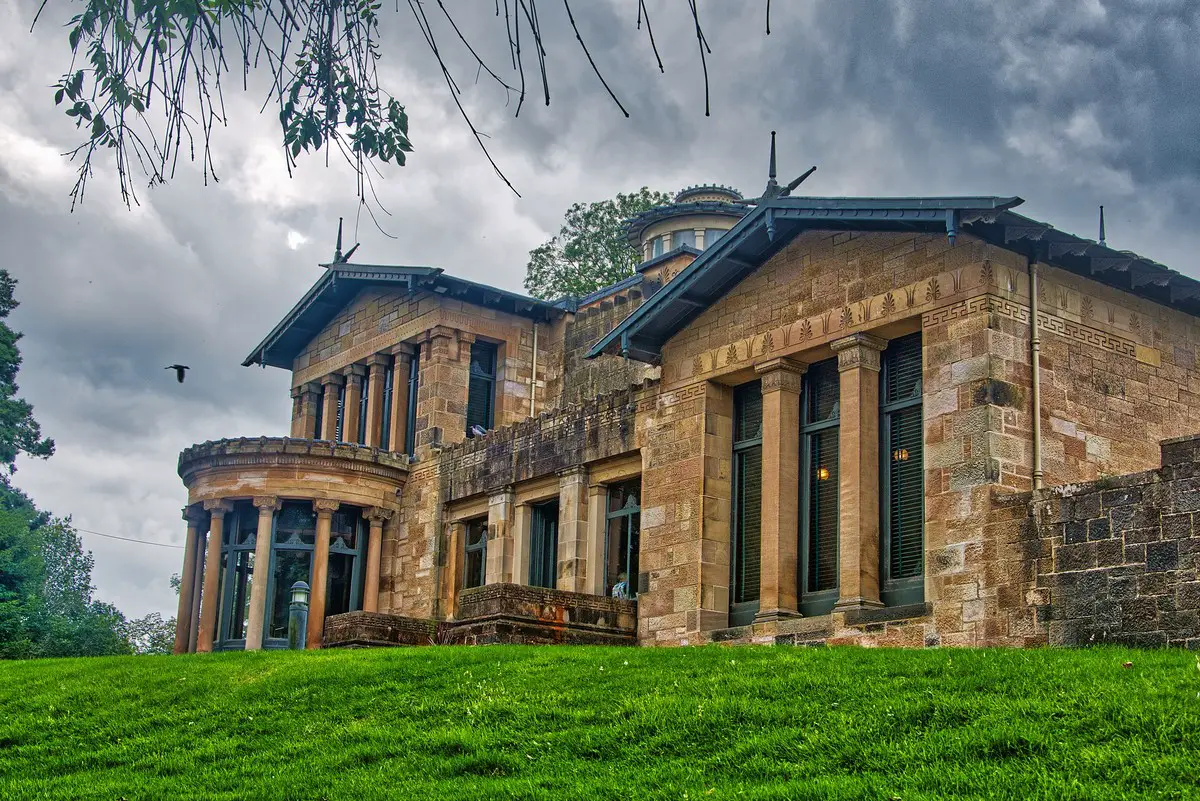
photo : Derek Rankine from Glasgow, Scotland, CC BY 2.0 https://creativecommons.org/licenses/by/2.0, via Wikimedia Commons
Description of this Greek Thomson building from The Glasgow Institute of Architects:
Holmwood House, Glasgow
Holmwood House is the finest and most elaborate villa designed by Alexander “Greek” Thomson, who now enjoys an international reputation as one of Scotland’s most original architects.
Recorded in minute detail in Blackie’s “Villa and Cottage Architecture” of 1868, Holmwood House had been built some ten years earlier at a cost of £3,600. Brothers and business partners James and Robert Couper, having selected a leafy site near the village of Cathcart for their adjoining homes, appointed two distinguished architects to meet their respective needs. While Robert’s home, “Sunnyside” was designed by James Smith in the Gothic style, James supported a far more adventurous and, indeed, innovative design in the Grecian style.
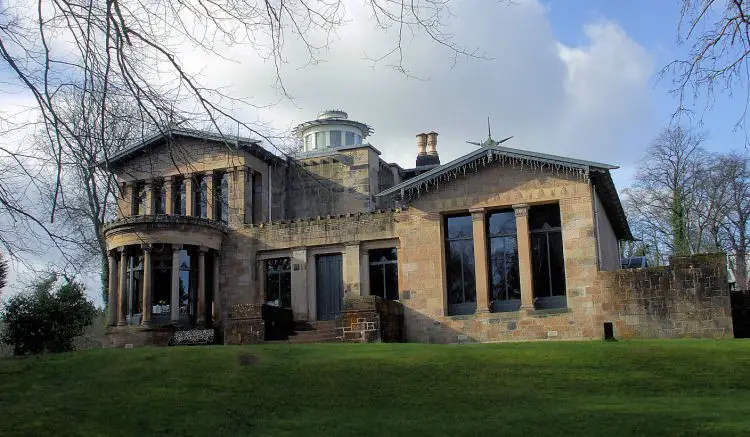
photograph : Zeddy at English Wikipedia, Public domain, via Wikimedia Commons
Here, his architect – Alexander Thomson – gathered together a range of ideas developed and refined in his previous domestic work, building the composition up from right to left (as seen from the entrance gates), elongating the whole through the inclusion of a low garden wall and coach house. The three principal rooms, being parlour, dining room and drawing room, were each expressed individually, all linked to a great cubic cliff of ashlar that rose out of the entrance hall to support a magnificent cupola.
In common with many other Glasgow buildings constructed at around the same time (including Thomson’s own house), Holmwood House is constructed of Giffnock freestone. While the architectural composition draws its strength, first, from the picturesque massing, and then from the distinctive and varied nature of the roofs, the incised ornament – to column heads, lintels, string courses and stair tower – plays an important role also. Shallow recesses – to the main entrance and to the returns on the drawing room gable – also appear, as do neat antefixa co-incident with parapets around flat-roofed areas. Furthermore, the shallowness of the roof pitches, the broad overhanging eaves and feature finials, and the squatness of the stair tower play an undeniably major part in the architectural composition of the house, as do the spectacular chimney pots and caps.
Relatively compact at first floor level, Holmwood House nevertheless has a sizeable ground floor plan, the parlour and dining room both flanking the long entrance hall, which has a small cloakroom and WC, and which draws the visitor tantalisingly towards light spilling down the staircase from the cupola. The kitchen wing can be reached from the dining room (via the butler’s pantry), or from the service corridor that extends the circulation route from the entrance hall to the kitchen court, with its astonishing encaustic tiled-floor. The layout of coal cellar, larder, laundry and other ancillary spaces differs from the plans published in Blackie, and there is an excessively complex series of interconnecting roof planes over the service wing, but there is good use of timber lining boards on walls, ceilings and as shutters. The kitchen also has a flagstone-floor finish that has endured well over the years. Internal decoration in the principal rooms has been revealed to be spectacular and quite unique.
Providing relatively modest sleeping accommodation, the upper floor originally comprised of a magnificent drawing room (with balcony over the parlour bay below), the upper stage of the staircase, two bedrooms and a dressing room (or third bedroom) and a bathroom accessed off the narrow hall. It has been established that the wall and ceiling decoration in the bedrooms was relatively plain.
That Holmwood House has survived at all is testament to the remarkable work of a number of people who recognised in 1989 that the house and grounds were in danger of ruination. One hundred years after its construction, the house had been purchased by the Sisters of Our Lady of the Missions, to whose sensitive retention of the interior (albeit under layers of paper and paint) successive generations owe a debt of gratitude. Custodians of the property for over thirty years, and with the relocation of their school imminent in 1990, the nuns were forced reluctantly to place Holmwood House on the market. And so, when at the time Glasgow City Council celebrated the work of Alexander Thomson in a small booklet funded from their Festivals Budget, the future of Holmwood was uncertain.
Happily, despite the almost complete loss of the external decorative timbers, the obscuring of the magnificent stencil work and frieze panels in the dining room under wallpaper (when used as a chapel), the state of disrepair into which the roof had fallen, and the partial demolition of the garden link wall, the house was still recognised as a work of major significance. Strong opposition to a developer’s proposals to build 93 flats and houses in the grounds, allied with the formation of the Alexander Thomson Society, created the opportunity for the National Trust for Scotland to acquire the house and its grounds, embarking on an extensive repairs programme in 1994, and welcoming the first visiting members of the public in 1998. Today, the house is celebrated as the finest example of Thomson’s residential work, the magnificent interior rivalled only by that of the former St. Vincent Street United Presbyterian Church in Glasgow.
Until restoration began, much of what was known about Holmwood House and its rich decorative scheme, came from “Villa and Cottage Architecture”. Once staff from Historic Scotland’s Stenhouse Conservation Centre began to investigate the wall surfaces it became clear that Holmwood contains “one of the most important and experimental of nineteenth-century Scottish interiors”. The original decoration that was subsequently uncovered plays a major role in attracting visitors to the property.
Currently, however, visitors are often puzzled by the way in which some of the spaces are presented. In this way, Thomson’s finest residential commission does not immediately compare well to (say) Charles Rennie Mackintosh’s Hill House, where so much of the furniture remains in-situ. There are no records of Thomson having designed furniture for the property (the Thomson sideboard in the dining room, once in the ownership of GIA, is said to have been designed for his own home).
As a result, the house is a work in progress as far as furnishings are concerned. Furniture that may have been bought by the Couper family for whom the house was built has been sourced where possible, but at present the parlour and other rooms feature very few pieces.
Although Thomson’s decorative schemes for the house were illustrated in Blackie’s “Villa and Cottage Architecture”, there are two overlying schemes in the parlour at present. These have been partially exposed through paint scrapes and subsequently covered over in lining paper. Less is known about the parlour than the other rooms, where the original stencilwork has been more comprehensively exposed. The National Trust for Scotland will in the long term properly restore the room, but for the meantime it is a space in limbo.
The property is Category A listed by Historic Scotland.
Alexander Greek Thomson Competition
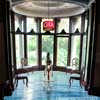
image © GIA
‘Reinventing the parlour at Holmwood House’
Alexander Greek Thomson Competition
The Glasgow Institute of Architects, as Trustees for the Alexander Thomson Scholarship, is pleased to announce the re-launch of the triennial competition established following Thomson’s death in 1875. Most famously won by Charles Rennie Mackintosh in 1890, the competition is open to all students of architecture and members of the profession throughout the UK whose age does not exceed 30 years on the date of entry. 17 Jun
Architecture in Strathclyde
Key Buildings designed by Alexander ‘Greek’ Thomson in the city of Glasgow
St Vincent Street Church
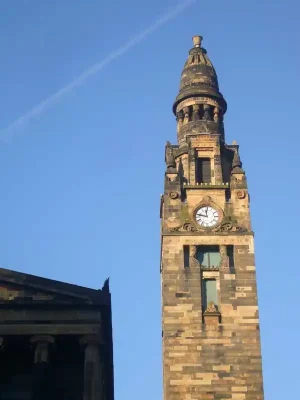
photo © Adrian Welch
CCA Glasgow – Grecian Chambers
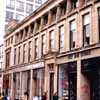
photo © Adrian Welch
Historic Glasgow Buildings
Briggait Centre : Nicoll Russell Studios
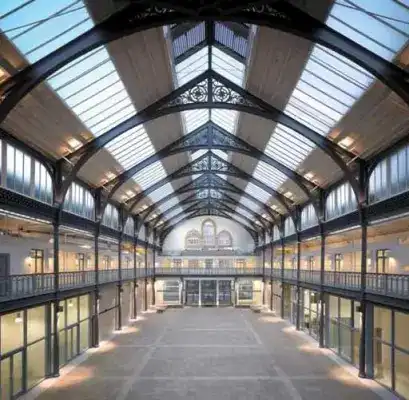
photo : Andrew Lee
House for an Art Lover
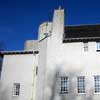
photo © Adrian Welch
Comments / photos for the Holmwood House Architecture – Cathcart Property page welcome